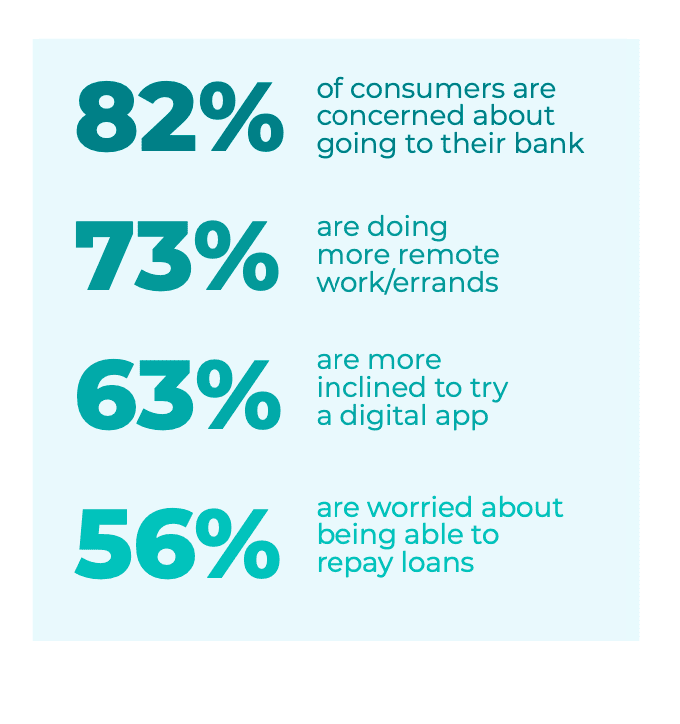Mobile consumer trends have touched new heights with the outbreak of Covid-19 which has disrupted the global economy like no other with the trendline dipping with uncertainty. This disruption has given an opportunity to a lot of companies to increase their digital adoption of products and services that were predominantly considered offline, especially banking enterprises. People are now armed with smartphones and easy data connectivity, technology-savvy customers now have a different set of expectations from their bankers.

(Downloads of Banking and Fintech Apps across various regions)
The global crisis caused by the Covid-19 pandemic influenced the financial behaviour of customers in a big way, Fintech and Banking apps have had a huge growth in Q2, 2020 as compared to Q1 2020. Banking, financial services, and insurance industry observed a 20.28% global growth in downloads on Mobile applications according to the latest Mobile Consumption Trends Report.
The Americas led the growth in downloads for this industry, posting a solid 43.67% growth in Q2 for app downloads, while the Global growth in Daily Active Users in the banking, financial services and insurance industry in Q2 was 5.96% as compared to Q1.
Meanwhile, India, Southeast Asia and Oceania saw a fall in Daily Active Users at -8.33% and -4.09% respectively.
Impact of Pandemic on Banking
The global crisis caused by the Covid-19 pandemic influenced the financial behaviour of customers in a big way:
- Cash and plastic cards were replaced by contactless payment modes such as digital wallets
- Bank owned and managed online apps became popular for lifestyle and utility-related payments
- Payment aggregators who unified different kinds of transactions on a single portal became popular.

Even today with the economy trying to gain back its momentum and banks opening up, customers are very much concerned about going to a physical bank branch and want to carry out more errands remotely. Thus, the heavy dependence on technology and mobile screens for all transactions has increased eventually.
While these numbers may not change in the rest of the 4 remaining months of 2020, it has given the mobile economy a whole new dimension with people relying more and more on technology to get through these tough times.
Banking for the Connected Customer
Banks are upgrading their infrastructure to reach customers where they are. Physical branches of most banks still exist but customers are being encouraged to carry out financial transactions via mobile phones or the bank’s website. This is also pushing banks to provide a great digital experience via mobile apps by simplifying financial processes
through seamless onboarding experiences, easier transactions such as remittances, pushing contactless payments, sending out targeted communications etc.
To complement these efforts, banks also need to build a strong omnichannel banking strategy to engage customers at the right touchpoint to carry out transactions. Why is an omnichannel strategy important? Usually a consumer switches between 2 or 3 screens before making a purchase – this shows how important it is for brands to be available on all channels to provide a consistent experience to all users which helps one to move from your app to website to push notifications to social media, experiencing the same branding and messaging throughout in a synchronized way.
The companies that use omnichannel strategies retain 89% of their customers on average as compared to 33% for those with weak omnichannel engagement.
How to Create Omnichannel Customer Engagement for Banks?
- Use Automation Tools – Personalization plays a heavy role in customer engagement game and automation helps in delivering this experience seamlessly. Omit manual processes and time-consuming activities & employ a customer engagement tool.
- Make Smart Recommendations- Use AI to perform faster and insightful segmentation to accurately predict consumer expectations. A recent BCG survey of global executives reports that 90% of marketers are now using AI to optimize the customer journey and deliver the most rewarding experience
- Get Data-Driven For Everything- Create a 360˚ view of your customer by synthesizing all customer data and accounting all their app/ online behaviour to optimize personalized conversations.
- Optimize For Every Channel – Engage users smartly by triggering communications across all channels such as SMS, push and in-app notifications, geolocation offers etc, to drive higher engagement.
Brands need to drive their focus on making sure they provide a smooth experience for customers while interacting with them on their respective gadgets. Starting from onboarding experience to building behaviour based lifecycle campaigns, reactivating dormant or lost customers and creating customised user journeys across customers lifecycle. Customers everywhere are looking for a Netflix experience in almost every other service. Automation and AI are keys to master your personalization game.
Author: Unnathi R
Unnathi is a marketer with a passion for learning anything new and indulging in various cultures while travelling. She enjoys a good read and a cup of coffee at any time of the day.


































